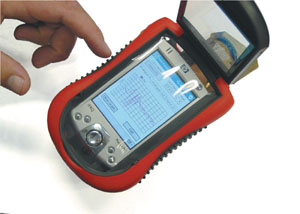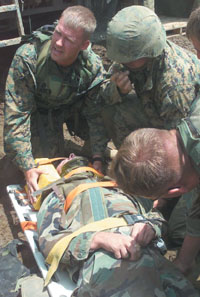Medics Triage From a Distance
 |
| The medical scancorder, under development at the U.S. Army Institute for Surgical Research in San Antonio, uses a microimpulse radar device built into a medical personal digital assistant to detect vital signs such as respiration and heart movement. |
Portable scanner determines casualty status with the push of a button.
Battlefield medical personnel may soon use a handheld device to perform rapid triage on wounded soldiers by remotely sensing vital functions such as respiration and heart rate without exposing themselves to enemy fire. A radar emitter built into the unit detects the movement of a person’s internal organs. With this equipment, medics can verify whether an individual is alive without removing body armor and equipment. More advanced versions of the system may permit medics to monitor the vital signs of up to 10 people simultaneously.
The ability to determine an injured person’s physical status quickly can be the difference between life and death on the battlefield or in any mass casualty situation. Advances in medical technology now allow individuals who can be stabilized and transported back to a hospital facility to have a greater chance of survival than ever before.
The U.S. Defense Department is researching a variety of technologies that will allow medical personnel to process wounded soldiers through triage efficiently, greatly improving an individual’s chances of survival and allowing scarce medical resources to be routed to where they are most needed.
One of these development programs is the medical scancorder. According to Dr. Victor Convertino, a research physiologist and task area manager for advanced capabilities for combat medics at the U.S. Army Institute for Surgical Research, San Antonio, the research evolved from a need to determine quickly whether a casualty was dead or alive. The current work is a spiral science and technology objective (STO) effort under the Army’s Casualty Care Research Program. Convertino explains that STO programs define products of specific military interest for development.
The program seeks to develop a vital signs monitor capable of detecting breathing and heart movement from a distance and through rubble. The scancorder incorporates a microimpulse radar developed at the Lawrence Livermore National Laboratory in New Mexico. This technology uses a wideband radar signal emitted from an antenna source that can discern the motion of internal organs. Convertino notes that one of the radar’s original applications was to help find disaster victims trapped in rubble. The scancorder can detect a person’s heart and lung motion at distances up to 100 feet through air and 20 feet through rubble, he says.
A prototype unit has been built into a U.S. military issue personal digital assistant (PDA). The radar emitter slides into one of the device’s computer board slots. Once installed, the unit becomes a part of the PDA’s functions. The radar emitter contains its own operating software to monitor organ movement and to display that information on the PDA screen. Convertino explains that because medical personnel already use PDAs for a number of applications, the program sought to integrate the scancorder into this multipurpose device.
To operate the current version of the scancorder, a medic points it at a wounded soldier or lays it on his or her chest. The radar then scans the patient for lung or heart movement through any body armor or equipment.
This scanning feature can complement other applications such as the Battlefield Medical Information System–Tactical (BMIST), which allows medics to track soldiers’ injury status as they are moved from the battlefield to rear-area surgical facilities. BMIST-enabled devices also can store data such as an individual’s medical, immunization and allergy records. This application lightens medics’ personal equipment loads because the medical reference texts they once had to carry are now loaded into the device. Special operations units already are using BMIST-equipped PDAs, and Convertino adds that the military plans to widely deploy the devices over the next several years.
By combining more features into a single device, the scancorder will reduce the amount of equipment medical personnel in the field require. “We are always told that the last thing soldiers want to do is carry another device. Our feeling was that we could integrate it and load it onto the same PDA that they are using for BMIST, and we have done that,” he explains.
The program has conducted tests of the equipment with volunteers wearing chemical and biological protective gear and body armor. Convertino notes that major tests will soon take place using animals. During these trials, the vital functions of test animals will be slowly lowered until they die. A major program goal is to record these decreasing signals. “That is the ultimate test. Does this track movement, not only while the animal or individual is alive, but when they die—will the signal go away?” offers Convertino.
The scancorder’s display currently shows two types of information. One screen image provides an oscilloscope function to illustrate detected organ movement. The second screen, the one most likely to be provided to a medic on the battlefield, provides a green circle if movement is detected and a red circle for no organ movement.
 |
| The scancorder will allow medics to determine an injured soldier’s vital signs quickly without removing body armor or other equipment on the battlefield. Medics also will be able to read a warfighter’s heart and lung rates from a distance without exposing themselves to enemy fire. |
Another future application under consideration is remote diagnosis. This feature would allow a medic to read vital signs or to conduct triage from a distance. Such a capability would have immediate uses on the battlefield because a medic could examine a soldier without being exposed to enemy fire. Convertino notes that statistics from the Vietnam War indicate that medics were twice as likely to be killed in action as were regular infantry.
Once the algorithms for interpreting heart and respiration rates are complete and tests are conducted, the next step will be to develop the device’s remote sensing capabilities. An intriguing part of the scancorder’s radar technology is that no detectors currently exist that can pick up its wideband signal, making it difficult for enemy forces to detect and triangulate on its radio frequency emissions.
Another avenue for research is developing a radar unit that is a part of a soldier’s uniform. This feature would make it easier for a medic to query a fallen warfighter’s physical status remotely and to conduct mass casualty triage. “One medic could take care of a number of casualties simply by aiming the device and getting the information,” Convertino says
Web Resources
Lawrence Livermore National Laboratory: www.llnl.gov/ipac/technology/profile/sensor/micropowerimpulseradar/index.php
SpecPro Incorporated: www.specpro-inc.com



